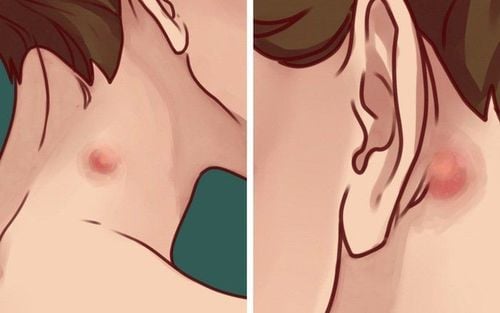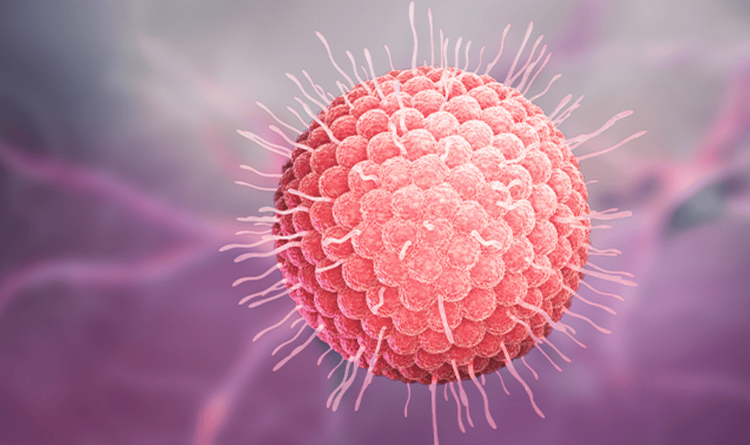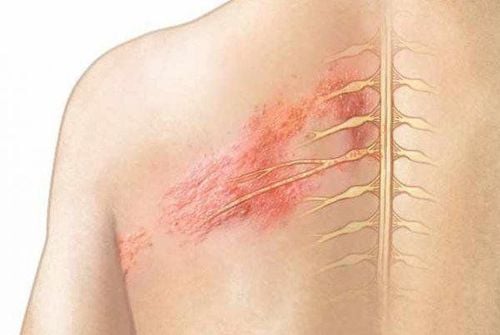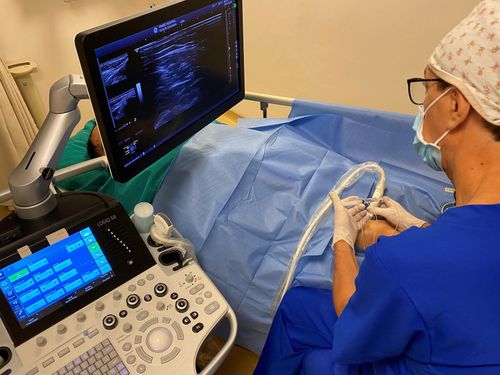This is an automatically translated article.
The article is professionally consulted by Master, Doctor Bui Ngoc Phuong Hoa - Department of Examination & Internal Medicine - Vinmec Danang International General HospitalShingles is a condition caused by the varicella-zoster virus - the same virus that causes chickenpox. Shingles is not contagious, however, the varicella-zoster virus (VZV) is very contagious and if you have shingles you can pass the virus on to others.
1. Symptoms of shingles
The main symptom of shingles is a rash appearing on the body such as:
Waist, back or chest Ears, eyes, mouth Internal organs, such as those in the digestive system or arteries in the brain . Blisters appear as a rash. After 7 to 10 days, the blisters begin to dry. Symptoms usually go away after 2-4 weeks.
Some manifestations of the rash include:
Red patches Water-filled and fragile blisters Rash localized around from the spine to the trunk Rash on the chest, face and ears,... Itching. Some of the signs and symptoms other than the rash are:
Muscle aches Chills Numbness and tingling Feeling of itching and burning, especially when the rash is painful Pain Swollen lymph nodes, a sign of the body's immune system you are fighting virus.

Also, the symptoms of internal shingles (internal shingles) are based on which part of the body is most affected. Parts that may be affected include the eyes, nervous system, lungs, liver, and brain. When shingles affects internal organs, it is a serious complication that requires prompt medical attention.
2. Causes of shingles
The varicella zoster virus (VZV) is the cause of shingles. It's the same virus that causes chickenpox. After having chickenpox, the virus can then enter the body and become active in certain nerves and tissues of the nervous system. After this, the virus can reactivate and appear as shingles. Shingles usually appears on the skin along the nerve line where it was previously dormant. If viral reactivation becomes severe, it can affect not only the skin but other organs as well. This is what is called systemic or internal shingles.
3. Is shingles contagious?
As mentioned above, shingles is not contagious so it can't be contagious. However, the varicella-zoster virus, which causes shingles, is very contagious, and if you have shingles, you can pass the virus on to other people, which can then cause them to get chickenpox. Especially for those who have never had chickenpox or have not been vaccinated against chickenpox, they should avoid contact with people with shingles because it is very likely that they will be infected if their resistance is low.
Anyone who has had chickenpox can get shingles; Even children can get shingles. Shingles cannot be passed from person to person.
4. How is shingles transmitted?
A person with shingles can often pass the varicella-zoster virus to someone who has never had chickenpox.
Shingles causes blisters to burst, and the varicella-zoster virus can be spread by contact with shingles blisters. If you haven't had chickenpox, you can get the varicella-zoster virus from contact with someone else's shingles blisters. This could be the cause of your chickenpox.
The virus is not spread after the blisters dry and crust over. Once the blisters crust over, they are no longer contagious. The virus also does not spread when the blisters are well covered.
You cannot get shingles from contact with the saliva or nasal secretions of someone who has shingles, except in rare cases. That means you usually can't get shingles if someone coughs or sneezes on you.
VZV from a person with shingles is less contagious than the virus from someone with chickenpox. The risk of spreading the virus is quite low.

To prevent spreading VZV to others, there are a few things to keep in mind:
Cover the rash. Avoid touching or scratching the rash Wash your hands often Avoid contact with the following people if you have shingles: Pregnant women who have never had chickenpox or the chickenpox vaccine; Premature or low birth weight babies People with weakened immune systems, such as those taking immunosuppressive drugs or undergoing chemotherapy, organ transplant recipients, and people infected with the human immunodeficiency virus (human immunodeficiency virus). HIV ).
5. Complications of shingles
In addition to the rash and symptoms of a viral infection, shingles can lead to complications, some of which can be serious, long-lasting. These include:
Vision loss, if shingles occurs in or near the eyes Hearing and balance problems if shingles appear in or around the ear Muscle weakness Facial paralysis Pneumonia Encephalitis Another complication is cord pain postherpetic neuralgia (PHN), affecting 10 to 18 percent of people who have had shingles.
Shingles travels along a nerve pathway, causing pain and strange sensations. Your skin may tingle or feel like it's burning before the blisters appear. Itching and sensitivity to the touch are also symptoms of shingles.
Shingles varies in severity and can be difficult to treat with over-the-counter pain relievers. Your doctor may prescribe antidepressants or steroids. These two drugs can successfully relieve nerve pain in some people.
A person with PHN will have persistent pain in the rash area after it clears up. The pain can be severe, and it can last for several years.

6. Prevention of shingles
One way to prevent shingles is to avoid contact with people who have shingles while they still have blisters on their bodies.
If a person gets chickenpox, they usually get it only once. The same is true for shingles. If they've had it before, they're more likely to get it again.
Immunization helps: Protects people from chickenpox and therefore also shingles; Protect people from shingles when they have had chickenpox or shingles.
The Centers for Disease Control and Prevention (CDC) recommends that children get the chickenpox vaccine in two doses: The first dose at 12 months of age; Second dose at 4 -6 years of age
Adolescents and adults 13 years of age and older who have never had chickenpox or have not been vaccinated, should get at least two doses of chickenpox vaccine. Some people should not get the chickenpox vaccine, including pregnant women and people who are currently moderately or severely ill. Some people should not get the vaccine, including pregnant or breastfeeding women and people who currently have shingles. Besides vaccinations, there are several other ways that can help you prevent shingles, including:
Get enough sleep; No smoking; Have regular check-ups with your doctor if you have any symptoms of illness; Strictly follow your treatment regimen, if you are diagnosed with shingles.
Please dial HOTLINE for more information or register for an appointment HERE. Download MyVinmec app to make appointments faster and to manage your bookings easily.
Reference source: Medicalnewstoday.com; cdc.gov; Healthline.com














